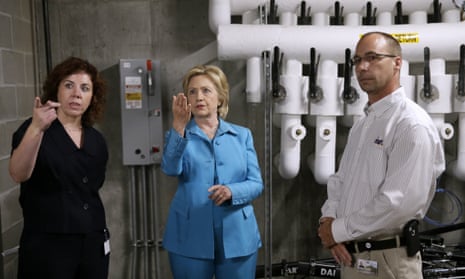Barack Obama ran for president promising to save the planet. Hillary Clinton is promising to help people save money on their electricity bills.
In the first big reveal of her climate change policy, Clinton said she would install half a billion new solar panels by the end of her first term in the White House, and generate enough renewable energy to power every home in the country 10 years after her inauguration.
“Not some homes. Not most homes. Every home in America,” she said in a speech on Monday at the main bus terminal in Des Moines.
The Democratic frontrunner for the 2016 presidential nomination cast climate change as one of the most urgent threats of our time – but she was also careful to raise the prospect of freeing Americans from their monthly utility bills as part of the solution.
“I personally believe climate change is a challenge of such magnitude and urgency that we need a president who will set ambitious goals,” Clinton told reporters.
The first such goal articulated by Clinton, set out in a video posted on her campaign website on Sunday night, called for installing half a billion new solar panels in her first term. Clinton set a target of generating 33% of America’s electricity from renewable sources, a more ambitious target than Obama.
But Clinton declined to stake out her position on the big decisions confronting the next president on climate change: Arctic drilling, fracking, oil and gas exports, and the hot button issue for Obama and Clinton, during her time as secretary of state: the future of the Keystone XL tar sands pipeline.
Clinton’s earlier position on Keystone – she said five years ago she was inclined to approve the project – has made her a target of environmental campaigners. She was heckled at an event in New Hampshire earlier this month when she refused to endorse a ban on oil and gas drilling on public lands “until we get alternatives in place”.
She managed to win over some campaigners on Monday, but only somewhat, and she was rebuked by the country’s main coal lobby.
Michael Brune, the Sierra Club’s executive director, said he was “thrilled” with Clinton’s renewable electricity goal, and her promise to defend Obama’s clean power plan.
But Bill McKibeen, the founder of the 350.org campaign group, said: “Hillary Clinton is half the way there.” McKibben said Clinton had made a “credible commitment” to renewable energy, but she could not dodge the difficult decisions ahead on Arctic drilling and coal extraction – let alone the Keystone pipeline . “At the end of the day, growth in renewables doesn’t mean enough if we’re simultaneously kicking the decarbonization can down the road with more pipelines and more extraction on public lands,” McKibben said.
Clinton’s reticence did not spare her criticism from the main coal lobby, Americans for Clean Coal Electricity, which said it was disappointed she “would continue the dog and pony climate show of the current administration”.
Other campaigners noted Clinton’s failure to spell out how she would defend Obama’s clean power plant rules – the pillar of his climate change plan – from attacks by Congress and the courts.
She was unclear about how she would would pay for her ambitious climate plan – given a Republican-controlled Congress that has been hostile to funding requests for energy and research.
“A lot of these changes will pay for themselves. There will be front end money needed,” she told reporters. “But there are ways of making those investments and getting a big return on those investment that will be to the benefit of the American taxpayer.”
But Clinton’s first big moment on the environment showed a candidate determined to couch climate change in the populist economic rhetoric of her campaign.
Obama, on the campaign trail, promised to save a “planet in peril”, and in the White House proposed climate measures that would save the equivalent in carbon pollution of shuttering multiple coal plants or taking millions of cars off the road.
Clinton in contrast said her plan would result in the equivalent of rooftop solar on 25 million American homes – which was a more populist approach, said Paul Bledsoe, who headed the White House climate change taskforce under Bill Clinton.
“There is a subtle message in here that her renewable energy plan will help consumers break free of utilities while helping to deal with climate change,” said Bledsoe. “It is explicitly framed in populist language.”
Rooftop solar grew by 76% last year a wave propelled by the plummeting prices of panels and government policy.
However, those pricing policies are under a sustained attack by some two dozen front groups and utility companies operating in 27 states, according to the Energy and Policy Institute.

Comments (…)
Sign in or create your Guardian account to join the discussion